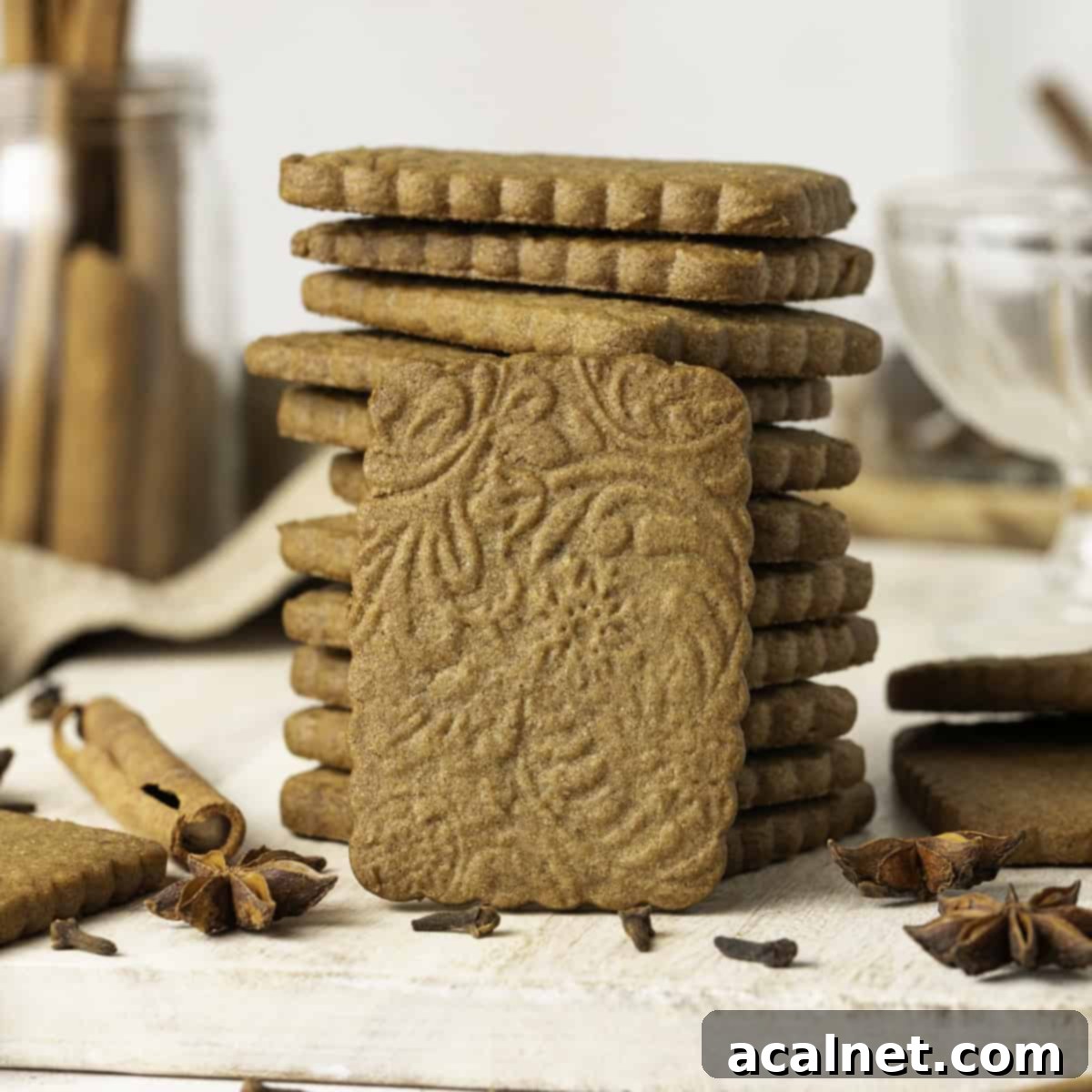Mastering Homemade Speculoos Cookies: The Authentic Belgian Biscoff Recipe
Dive into the delightful world of traditional Belgian Speculoos Cookies, often recognized globally as Biscoff Cookies! This comprehensive guide provides an incredibly easy and authentic recipe, allowing you to recreate these iconic spiced caramel biscuits right in your own kitchen. Prepare to be enchanted by their fragrant spice blend and deep caramelized flavor – they’re irresistibly addictive and a joy to bake from scratch!
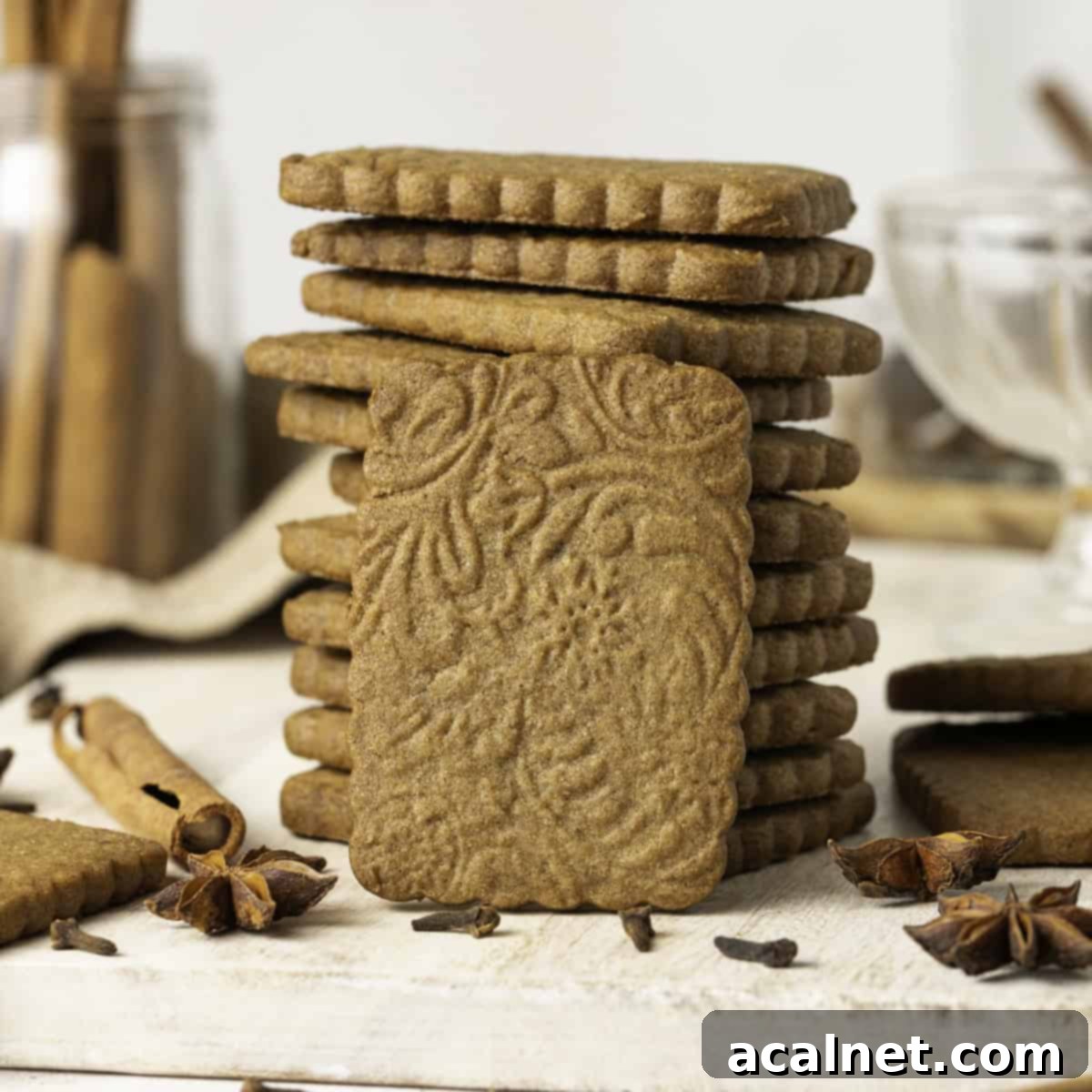
As someone with Belgian roots, I feel a profound connection to Speculoos. These aren’t just cookies; they’re a staple of Belgian culture and everyday life. I could talk passionately for hours about their rich history, their distinct qualities, and how they stack up against their commercialized counterpart, Lotus Biscoff cookies.
In Belgium, Speculoos are more than just a sweet treat. They’re traditionally served alongside every coffee ordered in cafes and restaurants, perfectly complementing the warm beverage. This ubiquity even inspired their commercial name “bis-coff,” cleverly abbreviating “BIScuit for COFFee.” There’s truly no better way to honor these beloved biscuits than by baking them from scratch at home, and the best part is, this homemade Speculoos cookie recipe is remarkably straightforward to follow!
What Exactly Are Speculoos Cookies?
Speculoos, also known by variations like Speculaas in the Netherlands or Spekulatius and Dutch Windmill Cookies in Germany, are traditional spiced shortcrust cookies deeply embedded in the culinary heritage of Belgium and its neighboring countries. These delightful biscuits are especially popular around the end-of-year holidays, particularly during celebrations like Saint Nicholas Day and Christmas.
They are renowned for their highly aromatic spice blend, which imparts a warm, complex flavor, and their signature deep caramelized taste. Traditionally, Speculoos cookies are not only delicious but also visually appealing. They are often made using intricately carved wooden cookie molds or embossed rolling pins, which imprint them with a variety of decorative shapes, ranging from people and animals to architectural scenes and seasonal motifs.
Historical accounts suggest that the original Speculoos were shaped to represent Saint Nicholas himself, reflecting their association with the festive season celebrated across Belgium, the Netherlands, and parts of Germany. Making them at home allows you to control the spice intensity and caramel notes, creating a truly superior cookie that captures the essence of this timeless tradition.
Essential Ingredients for Authentic Speculoos
Crafting the perfect Speculoos involves a specific set of ingredients, each playing a crucial role in achieving their distinctive flavor and texture. Let’s delve into what makes these cookies so special:
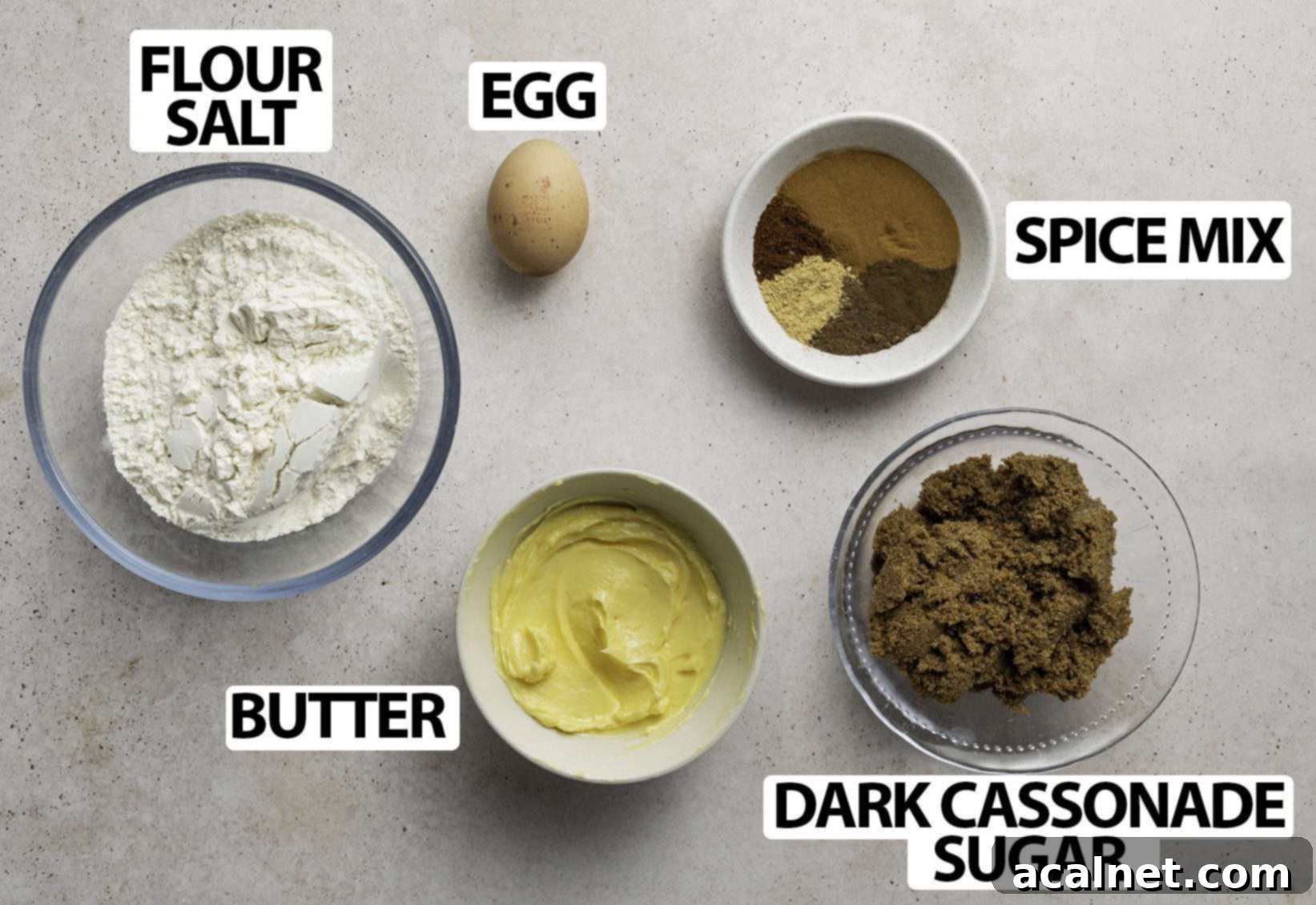
For precise quantities of each ingredient, please refer to the detailed recipe card located at the bottom of this page.
- Butter: Opt for unsalted butter that is softened to room temperature. This ensures it creams smoothly with the sugar, creating a tender, rich cookie base.
- Sugar: To achieve the most authentic taste, traditional Speculoos recipes call for Belgian Cassonade sugar, which is derived from sugar beet. This unique sugar contributes to the cookies’ signature deep caramel flavor and slightly sandy, yet tender, texture. If Belgian Cassonade is unavailable, excellent alternatives include dark brown sugar or muscovado sugar, both of which offer similar rich molasses notes.
- Egg: A large egg, also at room temperature, helps bind the dough and adds moisture, contributing to the cookie’s structure and preventing it from becoming too crumbly.
- Flour, Salt & Baking Soda: I typically use plain or all-purpose flour, which works perfectly for this recipe. However, cake flour can also be used for an even more delicate texture. Some traditional variations even incorporate whole wheat flour for a heartier bite. Salt balances the sweetness, while baking soda provides a slight lift and contributes to the cookie’s crispness.
- Spice Mix: The heart of Speculoos lies in its aromatic spice blend. As this is an ancient recipe, there isn’t a single definitive combination; rather, countless variations exist, depending on regional traditions and personal preferences. My carefully selected blend is detailed below, designed to deliver that unmistakable Speculoos warmth.
Indeed, the true essence of Speculoos is captured by two crucial ingredients: the distinctive dark Cassonade Sugar (or Brown Vergeoise Sugar) and the harmonious blend of fragrant spices.
Crafting Your Own Speculoos Spice Mix
The enchanting aroma and flavor of Speculoos come from a thoughtfully balanced spice mix. While commercial blends exist, creating your own allows for customization and ensures maximum freshness and potency. My preferred combination includes the following ground spices:
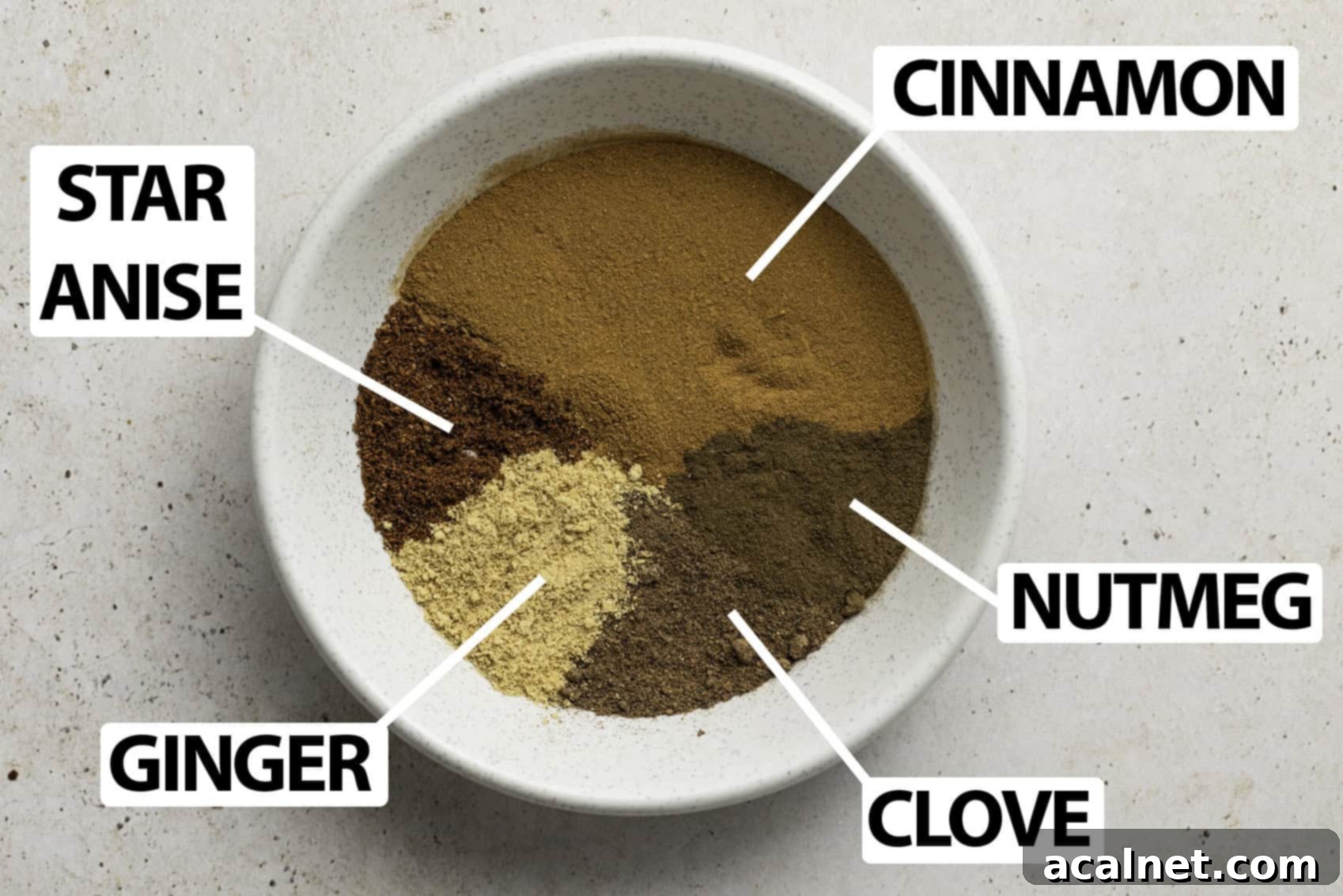
- Cinnamon: The dominant spice, providing warmth and sweetness.
- Nutmeg: Adds a warm, slightly nutty undertone.
- Clove: Offers a pungent, aromatic depth.
- Ginger: Contributes a subtle peppery zest.
- Star Anise: Delivers a distinct licorice-like note that elevates the blend.
Beyond these, many other spices can be found in various Speculoos recipes, such as coriander powder, white pepper, cardamom, or fennel powder. Feel free to experiment and create your unique spice blend to match your personal taste preferences! It’s worth noting that the variety of cinnamon commonly used in Belgium and the Netherlands is “Cassia,” which has a stronger, spicier flavor compared to Ceylon cinnamon (originating from Sri Lanka) often found in other countries like the US. This difference can subtly impact the final spice profile of your cookies.
Understanding Cassonade / Vergeoise Sugar
One of the biggest culinary challenges when making an authentic Speculoos recipe outside of Europe is sourcing the correct type of sugar. The sugar traditionally used in Belgium and France is uniquely made from sugar beet, a distinction from the more common sugar cane-based sugars found globally.
In Belgium, this sugar is known as Cassonade, often specifically Cassonade Graeffe. In France, it’s called Vergeoise. You might occasionally encounter it under the name “Candi Sugar,” though this term usually refers to rough, rock sugar crystals rather than the fine, moist sugar needed for Speculoos. It’s important to clarify that in France, “cassonade” typically refers to raw sugar cane sugar, which can lead to confusion for those seeking the sugar beet variety. This regional naming nuance highlights the specific nature of this ingredient.
Brown Cassonade boasts a remarkably deep caramel flavor and a characteristic sandy texture that is distinct from the crunchier texture of some brown sugars. This unique quality contributes significantly to the final taste and mouthfeel of authentic Speculoos. If you cannot find genuine Belgian Cassonade or French Vergeoise, don’t despair! A dark brown sugar or muscovado sugar makes an excellent substitute, providing a similar rich, molasses-like caramel flavor that will still yield delicious results.
Speculoos: Beyond the Plain Biscoff Shape
While commercial Lotus Biscoff cookies are recognizable for their relatively plain, often rectangular shape, traditional Speculoos Cookies are celebrated for their incredible diversity of decorated forms. These can include intricate depictions of people, animals, vegetation, and buildings, making them as much a visual treat as a culinary one. The traditional method for shaping Speculoos involves the use of beautifully carved wooden molds, which impart these detailed designs.
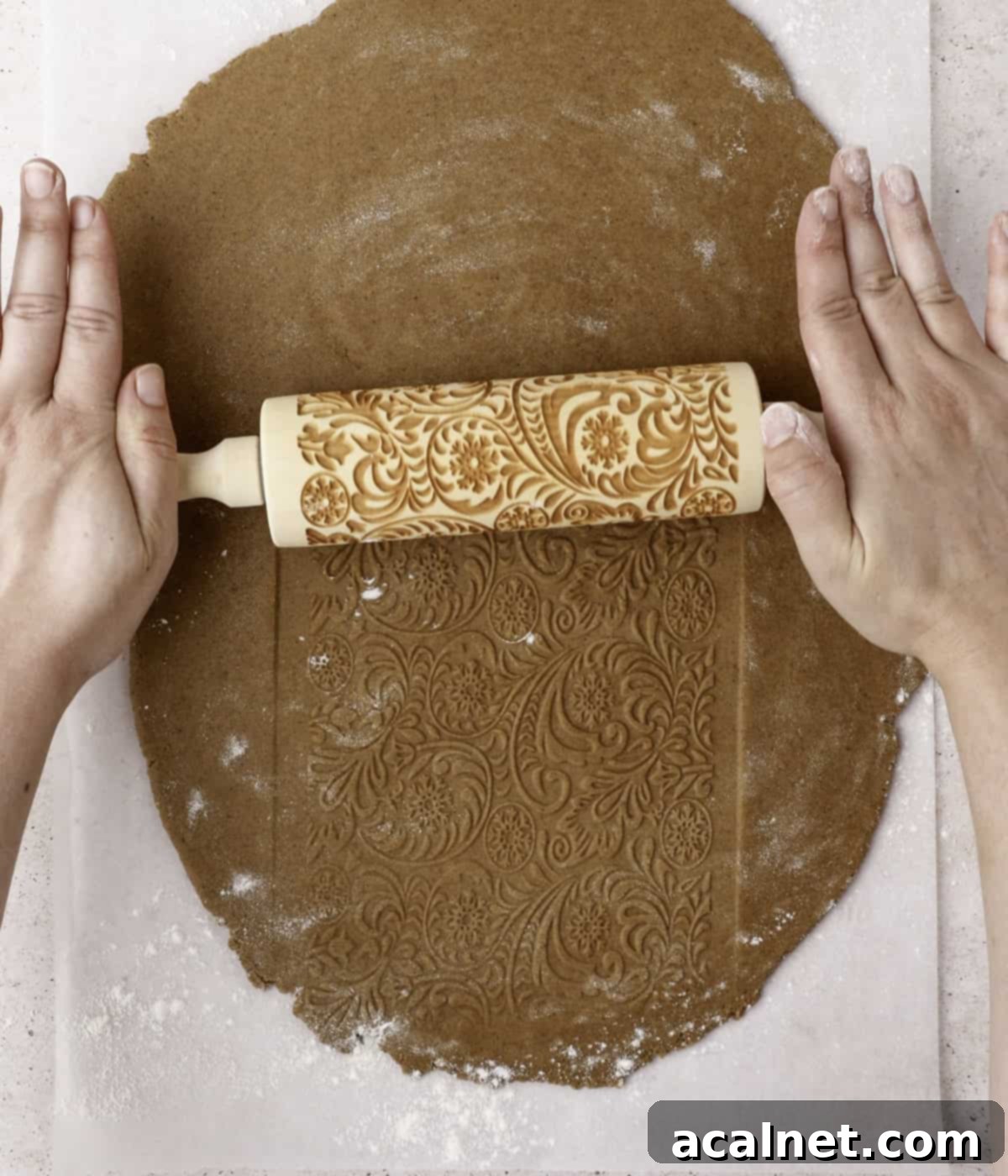
While these traditional wooden molds can be quite difficult, if not impossible, to find outside of Europe, and often require a bit of practice to master, there are excellent modern alternatives. You can achieve beautiful results using a combination of an embossed rolling pin and a cookie cutter, as demonstrated in this recipe. Alternatively, a simple cookie cutter will do just fine – rest assured, your homemade Speculoos will taste every bit as delicious, regardless of their shape!
Step-by-Step Guide: How to Make Speculoos Cookies
Making Speculoos cookies at home is a rewarding process that comes together quite easily. Follow these steps for perfect spiced caramel cookies:
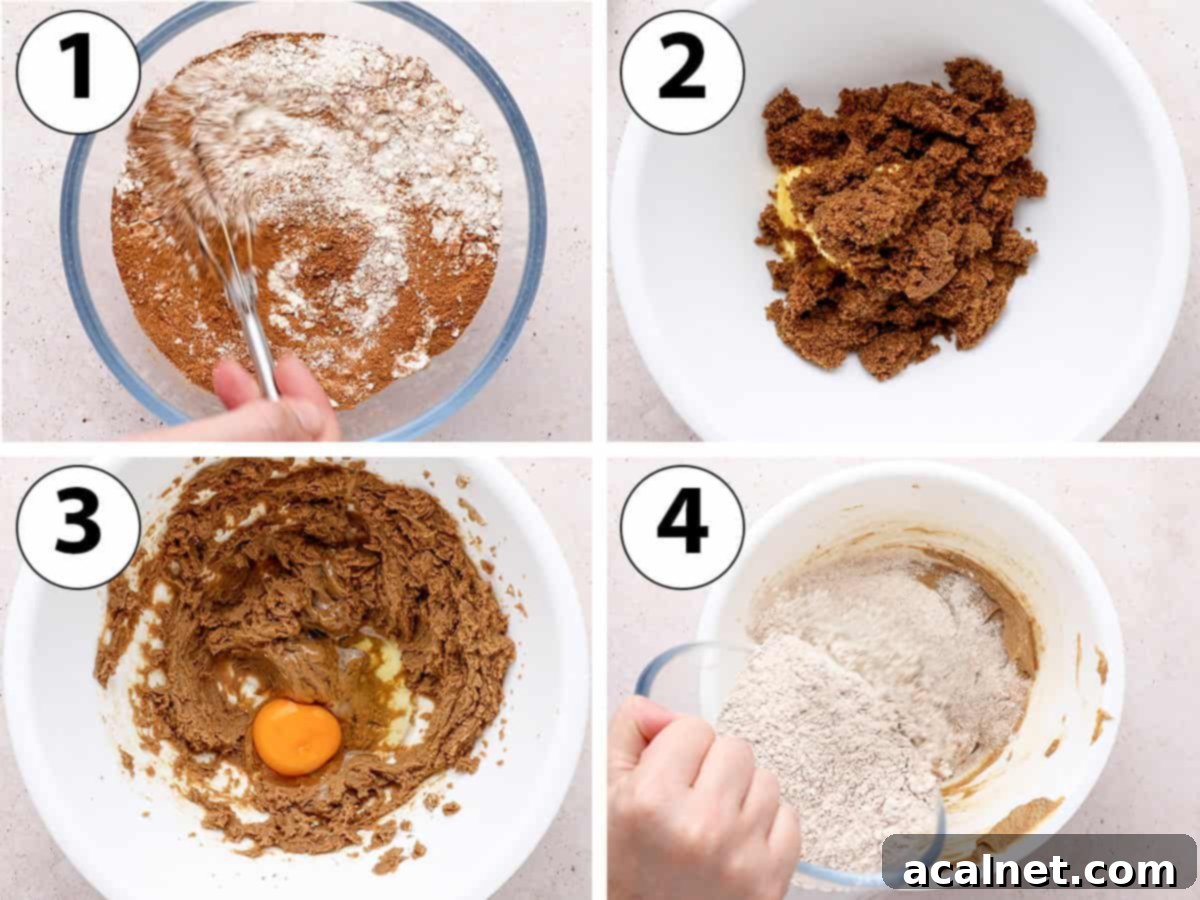
- Photo 1 (Dry Ingredients): Begin by combining all your dry ingredients – this includes the flour, salt, baking soda, and your carefully selected spice mix – in a small bowl. Whisk them together thoroughly to ensure even distribution of the leavening and spices. Set this mixture aside.
- Photo 2 (Creaming Butter and Sugar): In a large mixing bowl (or the bowl of a stand mixer fitted with the paddle attachment), add the softened unsalted butter and your chosen sugar. Using a hand mixer on medium speed, cream these two ingredients together for about 2 to 3 minutes. You’re looking for a thick, light paste, which indicates the butter and sugar are well combined and aerated.
- Photo 3 (Adding Egg): Incorporate the room-temperature egg into the creamed butter and sugar mixture. Mix slowly until it is fully combined. Avoid overmixing at this stage, just enough until it’s homogenous.
- Photo 4 (Combining Mixtures): Gradually add the reserved dry ingredient mixture to the wet ingredients.
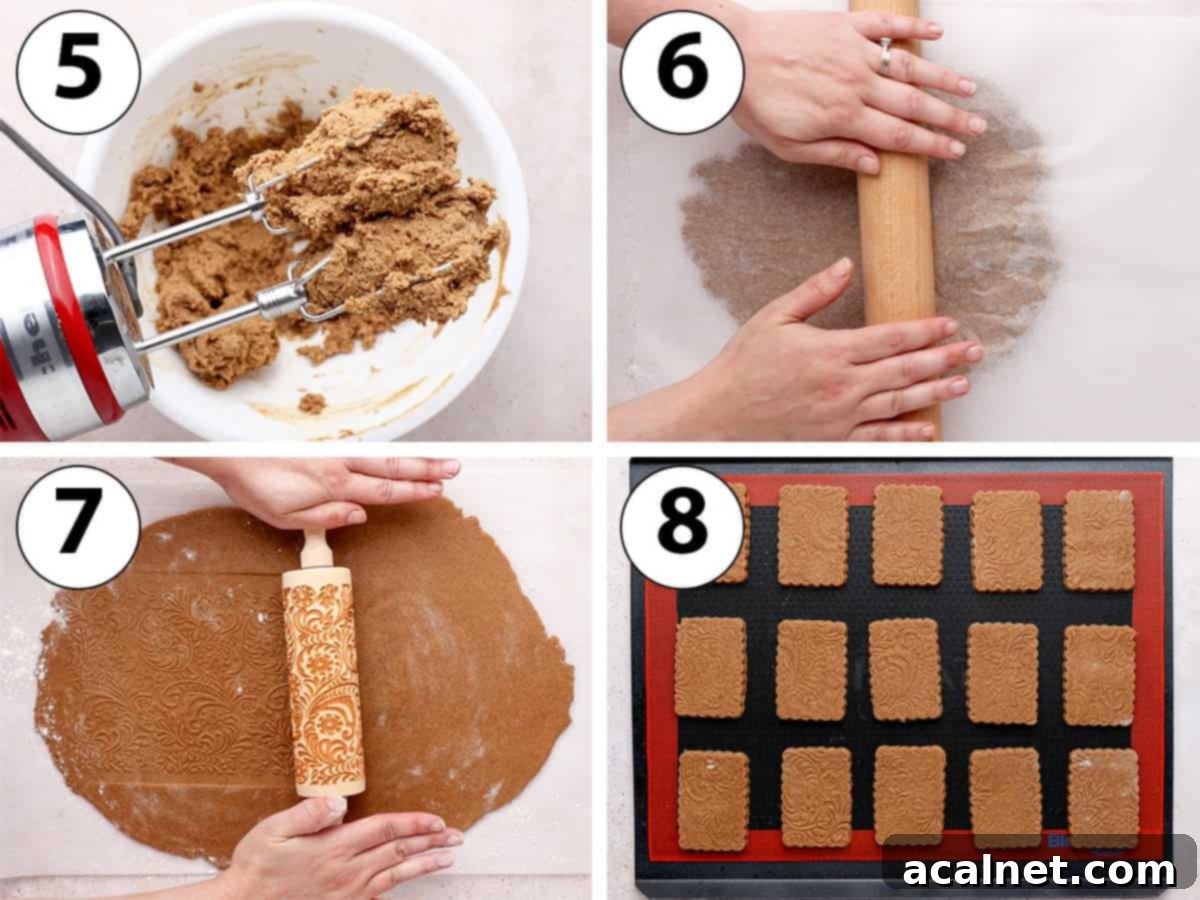
- Photo 5 (Forming the Dough): Mix on the lowest speed until a shaggy, rough dough just comes together. It will be relatively soft and slightly sticky, and you should no longer see any streaks of dry flour. Be careful not to overmix, as this can develop the gluten too much, leading to tough cookies.
- Photo 6 (Rolling the Dough): Transfer the dough between two large sheets of parchment paper or baking paper. Use your hands to roughly flatten it, then use a rolling pin to roll the dough evenly into a large disc, approximately 6 mm (or 1/4 inch) thick. For consistently even cookies, I highly recommend using a rolling pin with thickness rings.
- Photo 7 (Optional Embossing): If you’re opting for decorative patterns, gently peel off the top layer of baking paper and roll an embossed rolling pin over the dough. You’ll need to press quite firmly to ensure the pattern is deep enough to remain visible after baking. However, be mindful not to overly compress or thin the dough beyond its desired thickness.
- Chill the Dough: Carefully place the rolled dough (still between the parchment paper) onto a large baking sheet and transfer it to the fridge to chill for at least 2 hours. For optimal flavor development and a firmer dough that’s easier to handle, I strongly recommend chilling it overnight.
- Prepare for Baking: Preheat your oven to 160 degrees Celsius (325 degrees Fahrenheit). Line a flat baking tray with fresh baking paper. For the crispiest results and even baking, consider using a perforated baking tray in combination with a perforated baking mat.
- Cutting and Baking: Once chilled, remove the dough from the fridge and gently peel off the parchment paper. Using a rectangular fluted cookie cutter (or any cookie cutter of your choice), cut out your cookie shapes and carefully transfer them to the prepared baking sheet. Leave a small amount of space between each cookie, as they will expand slightly during baking. Any leftover dough scraps can be gently re-rolled, chilled again, and cut into more cookies.
- Bake the cookies for 14 to 15 minutes, or until their edges begin to turn a beautiful golden brown. Don’t worry if the centers still feel a little soft – they will firm up as they cool. Once baked, transfer the cookies to a wire rack and allow them to cool down completely before serving or storing them in an airtight container to maintain their freshness.

Common Questions About Speculoos Cookies
The term “Biscoff” is simply a brand name given to traditional Belgian Speculoos Cookies by the Belgian company Lotus when they began commercializing their product internationally, particularly outside of Europe. Essentially, all Biscoff cookies are a type of Speculoos, but not all Speculoos are Biscoff. Authentic Speculoos can vary greatly in spice blend, shape, and preparation method, often having a richer, more complex flavor profile than their mass-produced counterpart.
While incredibly similar and often confused, Speculoos are traditionally Belgian, whereas Speculaas are Dutch. Both are spiced cookies, but their respective recipes can feature subtle variations in the spice blend. Some sources might claim that Belgian Speculoos contain only cinnamon (likely due to the simplified spice profile of Lotus Biscoff), but I can confidently assure you that most artisanal Belgian Speculoos incorporate a much broader and more fragrant array of spices than just cinnamon, creating a truly distinct and complex flavor.
While both Speculoos and Gingerbread are spiced cookies and might appear similar at first glance, they are quite distinct in terms of taste, texture, and overall character. Gingerbread often features a stronger ginger flavor and can have a chewier or softer texture, with a more pronounced molasses note. Speculoos, on the other hand, typically have a crisper, almost shortbread-like texture and a complex caramel-spice profile where no single spice overwhelmingly dominates, resulting in a unique, balanced flavor.
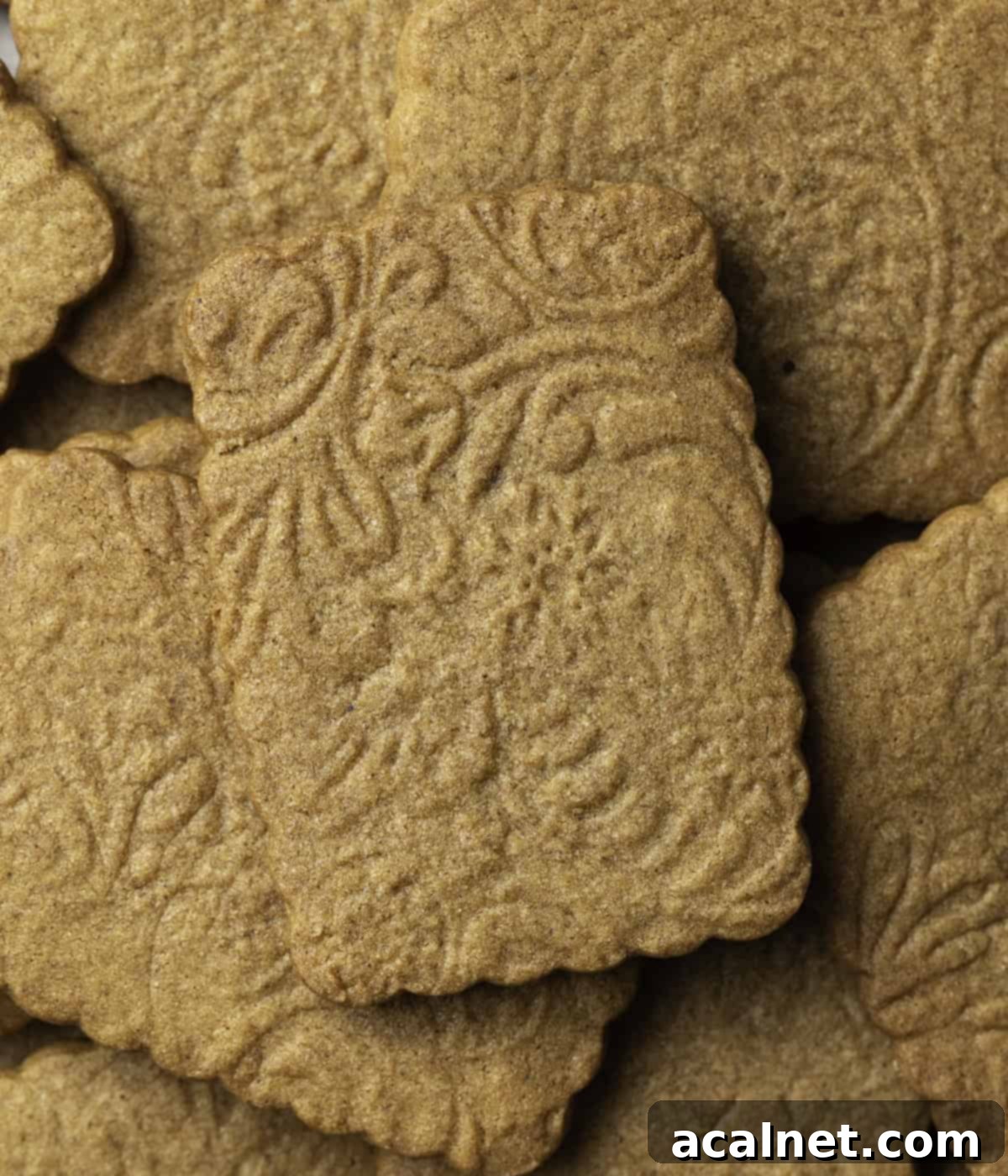
Pro Tips & Troubleshooting for Perfect Speculoos
Achieving the perfect Speculoos cookie is simple with a few insider tips:
- Sugar Substitutions for Authenticity: If you’re struggling to find traditional Belgian Cassonade or French Vergeoise sugar outside of Europe, don’t worry. A high-quality dark brown sugar or muscovado sugar will yield a wonderfully similar deep caramel flavor. While some recipes might suggest caramelizing white sugar in the oven, I’ve found that dark brown sugar is a far more convenient and equally effective substitute for achieving that distinct Speculoos taste.
- The Magic of Overnight Chilling: While the cookie dough can be baked after just 1-2 hours in the fridge, I cannot stress enough the importance of resting and chilling the dough overnight. This extended chilling period makes a phenomenal difference in both the depth of flavor and the rich golden-brown color of your baked cookies. It allows the flour to fully rehydrate and, more importantly, gives the spices ample time to thoroughly infuse the dough, resulting in a truly aromatic and complex cookie.
- Mastering Embossed Patterns: If you’re using an embossed rolling pin to create beautiful designs on your cookies, ensure you press it into the dough quite deeply. Speculoos cookies tend to spread slightly during baking, which means any lightly pressed pattern might blend into the cookie’s surface and become indistinct. Be cautious not to flatten the dough excessively while rolling, or you might consider starting with a slightly thicker dough than required, then gently pressing the design in.
- Even Baking: For best results, use a rolling pin with thickness rings. This ensures all your cookies are the same thickness, leading to uniform baking and consistent crispness.
- Cooling is Key: Always allow your Speculoos to cool completely on a wire rack. They are soft when they come out of the oven but will crisp up beautifully as they cool, developing their signature snap.
Storing & Freezing Your Homemade Speculoos
To keep your Speculoos cookies at their freshest and most delicious, proper storage is key.
These spiced caramel cookies are best enjoyed within approximately one week of baking. Store them in an airtight container at room temperature to maintain their crispness and flavor. It’s perfectly normal for the cookies to become slightly softer after a few days, a characteristic that some even prefer!
For longer storage, you have the option to freeze the cookie dough. You can either freeze it as one large, flattened disc (ensure it’s tightly wrapped in plastic wrap once fully frozen to prevent freezer burn) or freeze individual cut-out shapes. When you’re ready to bake, simply allow the frozen dough to thaw at room temperature for about 30 minutes before proceeding with the baking instructions. This is a fantastic way to have fresh, homemade Speculoos whenever the craving strikes!
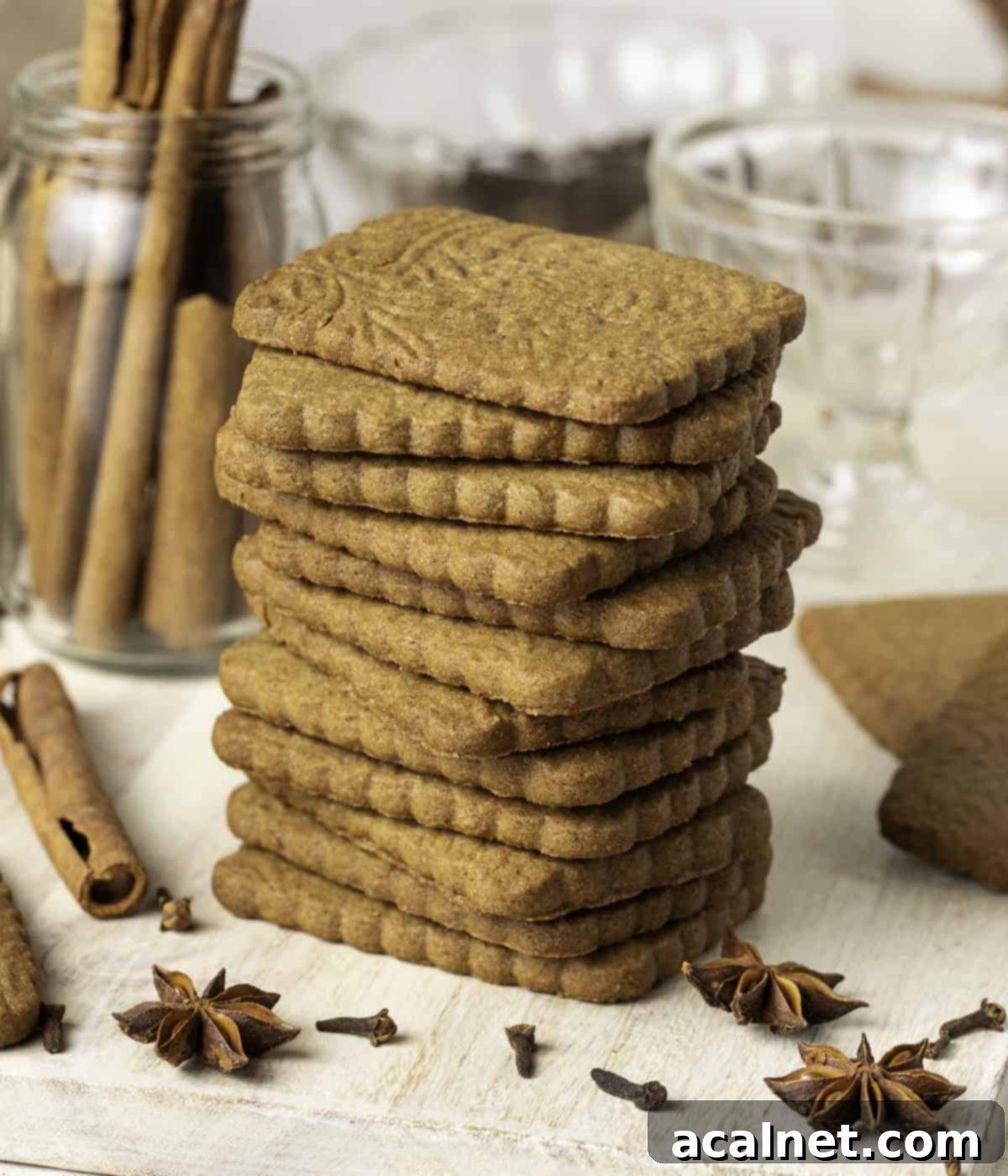
Delicious Recipes Using Speculoos & Biscoff Cookies
Once you’ve mastered the art of making homemade Speculoos, or if you simply have some store-bought Biscoff on hand, you’ll be delighted by the many ways these flavorful cookies can elevate other desserts. Here are some fantastic recipes where Speculoos or Biscoff cookies shine:
- Baked Speculoos Cheesecake
- Biscoff Cupcakes
- Baked Biscoff Donuts
- Mini Biscoff Cheesecakes
- Cookie Butter Ice Cream
- Easy Biscoff Muffins
- Cookie Butter Cake
- No-Bake Biscoff Cheesecake
- Speculoos Tiramisu
I am so excited to share that my debut cookbook
“Bite-Sized French Pastries for the Beginner Baker”
is now available for purchase!
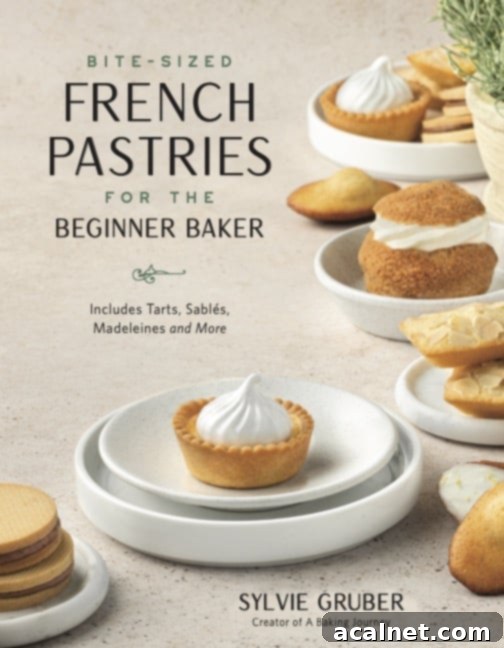
Full Recipe: Homemade Speculoos Cookies (Biscoff)

Homemade Speculoos Cookies (Biscoff)
Print Recipe
Ingredients
Dry Mix
- 250 gr Plain / All-Purpose Flour
- 1/2 teaspoon Baking Soda
- 1 generous pinch Fine Table Salt
- 2 teaspoon Ground Cinnamon
- 1/4 teaspoon Star Anise Powder
- 1/4 teaspoon Ground Ginger
- 1/4 teaspoon Ground Clove
- 1/4 teaspoon Ground Nutmeg
Wet Ingredients
- 200 gr Brown Cassonade / Vergeoise Sugar (see note 1), or Dark Brown Sugar / Muscavado Sugar
- 120 gr Unsalted Butter, very soft
- 1 large Egg, at room temperature
Instructions
- Combine the dry ingredients (flour, salt, baking soda and spices) in a bowl. Whisk to distribute and set aside.
- Place the soft butter and sugar in a large bowl (or the bowl of a stand mixer fitted with the paddle attachment). With a hand mixer set on medium speed, cream the soft butter and sugar for 2 to 3 minutes until you get a thick paste.
- Add the egg and mix on low speed until combined.
- Add the dry ingredients mixture. Mix on the lowest speed until a rough dough comes together (see note 2).
- Transfer the dough between two large sheets of baking paper. Roughly flatten with your hands then use a rolling pin to roll into a large disc that is about 6 mm or 1/4 inch thick (see note 3).
- Optional, if using an embossed rolling pin: remove the top layer of baking paper and go over the dough with the embossed rolling pin to create a pattern. It will need to be pressed in quite well to keep the pattern after baking, but try not to flatten the dough too much. If the dough get thiner, adjust the baking time accordingly.
- Place on top of a flat tray and transfer in the fridge to chill for at least 2 hours, preferably overnight (see note 4).
- Preheat your oven on 160 degrees Celsius / 325 degrees Fahrenheit. Prepare a flat baking tray with baking paper (see note 5).
- Remove from the fridge and gently peel off the parchment paper. Using a rectangular fluted cookie cutter (or a cookie cutter of your choice), cut out the dough and place over the prepared baking sheet. Leave a bit of room between each cookie as they will spread a little bit.
Any leftover dough can be re-rolled, chilled and cut for more cookies.
- Bake for 14 to 15 minutes or until the edges start to turn golden brown. Place on a wire rack and leave to cool down completely before serving.
Video
Would you like to save this recipe?
We’ll email this post to you, so you can come back to it later!
Notes
- The traditional way of making Speculoos is with Brown Cassonade (Belgian name) / Brown Vergeoise (French name), a type of sugar produced from sugar beets. This can be hard to find outside of Europe. If you don’t have this particular type of sugar, use Dark Brown Sugar or Muscovado Sugar instead for a relatively similar rich, caramel flavor.
- The dough should be relatively soft and sticky once combined. You shouldn’t see any streaks of flour anymore, ensuring a smooth, well-mixed consistency.
- For consistently even cookies, I highly recommend using a rolling pin with thickness rings. This tool ensures all your cookies are uniformly thick, which is essential for even baking.
- I highly recommend resting and chilling the dough overnight. This extended period makes a massive difference in both the taste and color of your cookies as the flour fully rehydrates and the spices deeply infuse the dough.
- For the best results, ensuring even heat distribution and a crispier bottom, I highly recommend using a perforated baking tray combined with a perforated baking mat.
Nutrition (per serving)
Made this recipe?
Let us know if you loved it by leaving a comment below, and don’t forget to tag us on Instagram @a.baking.journey with a photo of your delicious creation!
